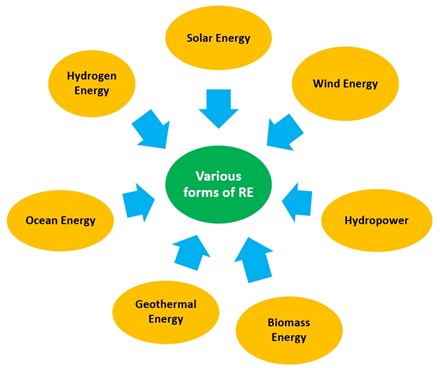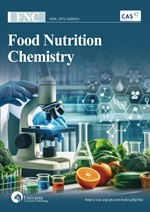Contribution of renewable energy technologies in combating phenomenon of global warming and minimizing GHG emissions
DOI:
https://doi.org/10.18686/cest.v2i2.164Keywords:
renewable energy; global warming; greenhouse effect; climate change; greenhouse gas (GHG) emission; carbon emissions; sustainable energy sourcesAbstract
The energy derived from fossil fuels significantly contributes to global warming (GW), accounting for over 75% of global greenhouse gas emissions and approximately 90% of all carbon dioxide emissions. It is crucial to rely on alternative energy from renewable energy (RE) to mitigate carbon emissions in the energy sector. Renewable energy sources have the potential to eliminate carbon from 90% of electricity generation by 2050, greatly reducing carbon emissions and helping alleviate the impacts of GW. By emphasizing the concept of zero emissions, the future of renewable energy becomes promising, with the possibility of replacing fossil fuels and limiting global temperature rise to 1.5 ℃ by 2050. In this article, renewable energy technologies and their role in various areas to combat GW are explored, examining trends and successes in supporting renewable energy policies and exploring available options to mitigate the effects of climate change and achieve a clean energy future. Moreover, RE offers a clean and sustainable alternative to fossil fuels, reducing reliance on them and minimizing greenhouse gas emissions. This paper also highlights the efforts of leading countries, including China, the United States, India, and Germany, in developing and utilizing renewable energy. These countries’ renewable energy strategies reflect their commitment to combat global warming and reduce harmful emissions for the well-being of present and future generations.

Downloads
Published
How to Cite
Issue
Section
License
Copyright (c) 2024 Ismail Marouani

This work is licensed under a Creative Commons Attribution 4.0 International License.
References
1. Candra O, Chammam A, Alvarez JRN, et al. The impact of renewable energy sources on the sustainable development of the economy and greenhouse gas emissions. Sustainability. 2023; 15(3): 2104. doi: 10.3390/su15032104 DOI: https://doi.org/10.3390/su15032104
2. Azizi H, Nejatian N. Evaluation of the climate change impact on the intensity and return period for drought indices of SPI and SPEI (study area: Varamin plain). Water Supply. 2022; 22(4): 4373-4386. doi: 10.2166/ws.2022.056 DOI: https://doi.org/10.2166/ws.2022.056
3. Molajou A, Pouladi P, Afshar A. Incorporating social system into water-food-energy nexus. Water Resources Management. 2021; 35: 4561-4580. doi: 10.1007/s11269-021-02967-4 DOI: https://doi.org/10.1007/s11269-021-02967-4
4. Sharifpur M, Ahmadi MH, Rungamornrat J, et al. Thermal management of solar photovoltaic cell by using single walled carbon nanotube (SWCNT)/water: numerical simulation and sensitivity analysis. Sustainability. 2022; 14(18): 11523. doi: 10.3390/su141811523 DOI: https://doi.org/10.3390/su141811523
5. Kandemir SY, Ozgur Yayli M, Acikkalp E. Assessment of Electric Energy Generation using Wind Energy in Turkey. 7th Iran Wind Energy Conference (IWEC2021). Published online May 17, 2021. doi: 10.1109/iwec52400.2021.9467019 DOI: https://doi.org/10.1109/IWEC52400.2021.9467019
6. Li L, Lin J, Wu N, et al. Review and outlook on the international renewable energy development. Energy and Built Environment. 2022; 3(2): 139-157. doi: 10.1016/j.enbenv.2020.12.002 DOI: https://doi.org/10.1016/j.enbenv.2020.12.002
7. Zou C, Xiong B, Xue H, et al. The Role of New Energy in Carbon Neutral. Petroleum Exploration and Development. 2021; 48, 480–491. doi: 10.1016/S1876-3804(21)60039-3 DOI: https://doi.org/10.1016/S1876-3804(21)60039-3
8. Abdullah WSW, Osman M, Ab Kadir MZA, et al. The Potential and Status of Renewable Energy Development in Malaysia. Energies. 2019; 12(12): 2437. doi: 10.3390/en12122437 DOI: https://doi.org/10.3390/en12122437
9. Qadir SA, Al-Motairi H, Tahir F, et al. Incentives and strategies for financing the renewable energy transition: A review. Energy Reports. 2021; 7: 3590-3606. doi: 10.1016/j.egyr.2021.06.041 DOI: https://doi.org/10.1016/j.egyr.2021.06.041
10. Markaki M, Belegri-Roboli A, Michaelides P, et al. The impact of clean energy investments on the Greek economy: An input–output analysis (2010–2020). Energy Policy. 2013; 57: 263-275. doi: 10.1016/j.enpol.2013.01.047 DOI: https://doi.org/10.1016/j.enpol.2013.01.047
11. Potrč S, Čuček L, Martin M, et al. Sustainable renewable energy supply networks optimization – The gradual transition to a renewable energy system within the European Union by 2050. Renewable and Sustainable Energy Reviews. 2021; 146: 111186. doi: 10.1016/j.rser.2021.111186 DOI: https://doi.org/10.1016/j.rser.2021.111186
12. Alawida M, Samsudin A, Teh JS. Enhanced digital chaotic maps based on bit reversal with applications in random bit generators. Information Sciences. 2020; 512: 1155-1169. doi: 10.1016/j.ins.2019.10.055 DOI: https://doi.org/10.1016/j.ins.2019.10.055
13. Smirnova E, Kot S, Kolpak E, et al. Governmental support and renewable energy production: A cross-country review. Energy. 2021; 230: 120903. doi: 10.1016/j.energy.2021.120903 DOI: https://doi.org/10.1016/j.energy.2021.120903
14. Wang B, Zhao W. Interplay of renewable energy investment efficiency, shareholder control and green financial development in China. Renewable Energy. 2022; 199: 192-203. doi: 10.1016/j.renene.2022.08.122 DOI: https://doi.org/10.1016/j.renene.2022.08.122
15. Li Y, Ramzan M, Li X, et al. Determinants of carbon emissions in Argentina: The roles of renewable energy consumption and globalization. Energy Reports. 2021; 7: 4747-4760. doi: 10.1016/j.egyr.2021.07.065 DOI: https://doi.org/10.1016/j.egyr.2021.07.065
16. Zahraoui Y, Khan MRB, AlHamrouni I, et al. Current Status, Scenario, and Prospective of Renewable Energy in Algeria: A Review. Energies. 2021; 14(9): 2354. doi: 10.3390/en14092354 DOI: https://doi.org/10.3390/en14092354
17. Li R, Leung GCK. The relationship between energy prices, economic growth and renewable energy consumption: Evidence from Europe. Energy Reports. 2021; 7: 1712-1719. doi: 10.1016/j.egyr.2021.03.030 DOI: https://doi.org/10.1016/j.egyr.2021.03.030
18. Levenda AM, Behrsin I, Disano F. Renewable energy for whom? A global systematic review of the environmental justice implications of renewable energy technologies. Energy Research & Social Science. 2021; 71: 101837. doi: 10.1016/j.erss.2020.101837 DOI: https://doi.org/10.1016/j.erss.2020.101837
19. Dickert C, Parker S. What electricity sources power the world? Available online: https://www.visualcapitalist.com/electricity-sources-by-fuel-in-2022/ (accessed on 1 May 2024).
20. Wall WP, Khalid B, Urbański M, et al. Factors Influencing Consumer’s Adoption of Renewable Energy. Energies. 2021; 14(17): 5420. doi: 10.3390/en14175420 DOI: https://doi.org/10.3390/en14175420
21. Jin L, Chang Y-H, Wang M, et al. The dynamics of CO2 emissions, energy consumption, and economic development: evidence from the top 28 greenhouse gas emitters. Environmental Science and Pollution Research. 2022; 29(24): 36565-36574. doi: 10.1007/s11356-021-18069-y DOI: https://doi.org/10.1007/s11356-021-18069-y
22. Wang Q, Wang L, Li R. Trade protectionism jeopardizes carbon neutrality—Decoupling and breakpoints roles of trade openness. Sustainable Production and Consumption. 2023; 35: 201-215. doi: 10.1016/j.spc.2022.08.034 DOI: https://doi.org/10.1016/j.spc.2022.08.034
23. Wang Q, Zhang F, Li R. Revisiting the environmental Kuznets curve hypothesis in 208 counties: The roles of trade openness, human capital, renewable energy and natural resource rent. Environmental Research. 2023; 216: 114637. doi: 10.1016/j.envres.2022.114637 DOI: https://doi.org/10.1016/j.envres.2022.114637
24. Wang Q, Yang T, Li R. Does income inequality reshape the environmental Kuznets curve (EKC) hypothesis? A nonlinear panel data analysis. Environmental Research. 2023; 216: 114575. doi: 10.1016/j.envres.2022.114575 DOI: https://doi.org/10.1016/j.envres.2022.114575
25. Barthelmie RJ, Pryor SC. Climate Change Mitigation Potential of Wind Energy. Climate. 2021; 9(9): 136. doi: 10.3390/cli9090136 DOI: https://doi.org/10.3390/cli9090136
26. Odeh NA, Cockerill TT. Life cycle GHG assessment of fossil fuel power plants with carbon capture and storage. Energy Policy. 2008; 36(1): 367-380. doi: 10.1016/j.enpol.2007.09.026 DOI: https://doi.org/10.1016/j.enpol.2007.09.026
27. Spath PL, Mann MK. Life cycle assessment of a natural gas combined-cycle power generation system. Available online: https://www.nrel.gov/docs/fy00osti/27715.pdf (accessed on 28 May 2024).
28. Dolan SL, Heath GA. Life Cycle Greenhouse Gas Emissions of Utility‐Scale Wind Power. Journal of Industrial Ecology. 2012; 16(s1). doi: 10.1111/j.1530-9290.2012.00464.x DOI: https://doi.org/10.1111/j.1530-9290.2012.00464.x
29. Fthenakis VM, Kim HC. Greenhouse-gas emissions from solar electric- and nuclear power: A life-cycle study. Energy Policy. 2007; 35(4): 2549-2557. doi: 10.1016/j.enpol.2006.06.022 DOI: https://doi.org/10.1016/j.enpol.2006.06.022
30. National Renewable Energy Laboratory (NREL). Life Cycle Greenhouse Gas Emissions from Electricity Generation: Update. Available online: https://www.nrel.gov/docs/fy21osti/80580.pdf (accessed on 28 May 2024).
31. IEA. Key World Energy Statistics 2020. Available online: https://www.iea.org/reports/key-world-energy-statistics-2020 (accessed on 28 May 2024).
32. Edenhofer O, Pichs-Madruga R, Sokona Y, et al., eds. Renewable Energy Sources and Climate Change Mitigation. Cambridge University Press; 2011. doi: 10.1017/cbo9781139151153 DOI: https://doi.org/10.1017/CBO9781139151153
33. Carola PT. A methodology and a mathematical model for reducing greenhouse gas emissions through the supply chain redesign. Available online: https://upcommons.upc.edu/handle/2117/121042?locale-attribute=en (accessed on 28 May 2024).
34. Bonou A, Laurent A, Olsen SI. Life cycle assessment of onshore and offshore wind energy-from theory to application. Applied Energy. 2016; 180: 327-337. doi: 10.1016/j.apenergy.2016.07.058 DOI: https://doi.org/10.1016/j.apenergy.2016.07.058
35. International Energy Agency (IEA). CO2 Emissions in 2022. Available online: https://www.iea.org/reports/co2-emissions-in-2022 (accessed on 28 May 2024).
36. GWEC. Global Wind Report 2021. Available online: https://gwec.net/global-wind-report-2021/ (accessed on 28 May 2024).
37. IRENA. Untapped Potential for Climate Action. Available online: https://www.irena.org/-/media/Files/IRENA/Agency/Publication/2017/Nov/IRENA_Untapped_potential_NDCs_2017.pdf (accessed on 28 May 2024).
38. IEA. CO2 Emissions in 2022. Available online: https://iea.blob.core.windows.net/assets/3c8fa115-35c4-4474-b237-1b00424c8844/CO2Emissionsin2022.pdf (accessed on 1 May 2024).
39. IEA. Net Zero by 2050. Available online: https://www.iea.org/reports/net-zero-by-2050 (accessed on 28 May 2024).
40. IEA. The Role of China’s ETS in Power Sector Decarbonisation. Available online: https://www.iea.org/reports/the-role-of-chinas-ets-in-power-sector-decarbonisation (accessed on 28 May 2024).
41. Zhang X, Guo X, Zhang X. Assessing and prospecting decoupling effect of carbon emissions from economic growth: Empirical studies from Chinese provinces. Energy & Environment. 2022; 34(6): 2044-2071. doi: 10.1177/0958305x221100534 DOI: https://doi.org/10.1177/0958305X221100534
42. Dutta A, Farooq S, Karimi IA, et al. Assessing the potential of CO 2 utilization with an integrated framework for producing power and chemicals. Journal of CO2 Utilization. 2017; 19: 49-57. doi: 10.1016/j.jcou.2017.03.005 DOI: https://doi.org/10.1016/j.jcou.2017.03.005
43. Kılkış Ş, Krajačić G, Duić N, et al. Advances in integration of energy, water and environment systems towards climate neutrality for sustainable development. Energy Conversion and Management. 2020; 225: 113410. doi: 10.1016/j.enconman.2020.113410 DOI: https://doi.org/10.1016/j.enconman.2020.113410
44. Li Y, Yu L, Chen L, et al. Subtle Side Chain Triggers Unexpected Two-Channel Charge Transport Property Enabling 80% Fill Factors and Efficient Thick-Film Organic Photovoltaics. The Innovation. 2021; 2(1): 100090. doi: 10.1016/j.xinn.2021.100090 DOI: https://doi.org/10.1016/j.xinn.2021.100090
45. Yoo JJ, Seo G, Chua MR, et al. Efficient perovskite solar cells via improved carrier management. Nature. 2021; 590(7847): 587-593. doi: 10.1038/s41586-021-03285-w DOI: https://doi.org/10.1038/s41586-021-03285-w
46. Aydin E, Allen TG, De Bastiani M, et al. Interplay between temperature and bandgap energies on the outdoor performance of perovskite/silicon tandem solar cells. Nature Energy. 2020; 5(11): 851-859. doi: 10.1038/s41560-020-00687-4 DOI: https://doi.org/10.1038/s41560-020-00687-4
47. Marchi M, Niccolucci V, Pulselli RM, et al. Environmental policies for GHG emissions reduction and energy transition in the medieval historic centre of Siena (Italy): The role of solar energy. Journal of Cleaner Production. 2018; 185: 829-840. doi: 10.1016/j.jclepro.2018.03.068 DOI: https://doi.org/10.1016/j.jclepro.2018.03.068
48. Zhou Z, Lin A, Wang L, et al. Estimation of the losses in potential concentrated solar thermal power electricity production due to air pollution in China. Science of The Total Environment. 2021; 784: 147214. doi: 10.1016/j.scitotenv.2021.147214 DOI: https://doi.org/10.1016/j.scitotenv.2021.147214
49. Di Leo S, Pietrapertosa F, Salvia M, et al. Contribution of the Basilicata region to decarbonisation of the energy system: results of a scenario analysis. Renewable and Sustainable Energy Reviews. 2021; 138: 110544. doi: 10.1016/j.rser.2020.110544 DOI: https://doi.org/10.1016/j.rser.2020.110544
50. Koumi Ngoh S, Njomo D. An overview of hydrogen gas production from solar energy. Renewable and Sustainable Energy Reviews. 2012; 16(9): 6782-6792. doi: 10.1016/j.rser.2012.07.027 DOI: https://doi.org/10.1016/j.rser.2012.07.027
51. Ishaq H, Dincer I. Comparative assessment of renewable energy-based hydrogen production methods. Renewable and Sustainable Energy Reviews. 2021; 135: 110192. doi: 10.1016/j.rser.2020.110192 DOI: https://doi.org/10.1016/j.rser.2020.110192
52. Shih CF, Zhang T, Li J, et al. Powering the Future with Liquid Sunshine. Joule. 2018; 2(10): 1925-1949. doi: 10.1016/j.joule.2018.08.016 DOI: https://doi.org/10.1016/j.joule.2018.08.016
53. Olabi AG, Wilberforce T, Elsaid K, et al. Selection Guidelines for Wind Energy Technologies. Energies. 2021; 14(11): 3244. doi: 10.3390/en14113244 DOI: https://doi.org/10.3390/en14113244
54. Ren K, Tang X, Wang P, et al. Bridging energy and metal sustainability: Insights from China’s wind power development up to 2050. Energy. 2021; 227: 120524. doi: 10.1016/j.energy.2021.120524 DOI: https://doi.org/10.1016/j.energy.2021.120524
55. Yuan Z, Yin Y, Xie C, et al. Advanced Materials for Zinc‐Based Flow Battery: Development and Challenge. Advanced Materials. 2019; 31(50). doi: 10.1002/adma.201902025 DOI: https://doi.org/10.1002/adma.201902025
56. Bueno C, Carta JA. Wind powered pumped hydro storage systems, a means of increasing the penetration of renewable energy in the Canary Islands. Renewable and Sustainable Energy Reviews. 2006; 10(4): 312-340. doi: 10.1016/j.rser.2004.09.005 DOI: https://doi.org/10.1016/j.rser.2004.09.005
57. Deane JP, Ó Gallachóir BP, McKeogh EJ. Techno-economic review of existing and new pumped hydro energy storage plant. Renewable and Sustainable Energy Reviews. 2010; 14(4): 1293-1302. doi: 10.1016/j.rser.2009.11.015 DOI: https://doi.org/10.1016/j.rser.2009.11.015
58. Rehman S, Al-Hadhrami LM, Alam MM. Pumped hydro energy storage system: A technological review. Renewable and Sustainable Energy Reviews. 2015; 44: 586-598. doi: 10.1016/j.rser.2014.12.040 DOI: https://doi.org/10.1016/j.rser.2014.12.040
59. Budt M, Wolf D, Span R, et al. A review on compressed air energy storage: Basic principles, past milestones and recent developments. Applied Energy. 2016; 170: 250-268. doi: 10.1016/j.apenergy.2016.02.108 DOI: https://doi.org/10.1016/j.apenergy.2016.02.108
60. Lund H, Salgi G. The role of compressed air energy storage (CAES) in future sustainable energy systems. Energy Conversion and Management. 2009; 50(5): 1172-1179. doi: 10.1016/j.enconman.2009.01.032 DOI: https://doi.org/10.1016/j.enconman.2009.01.032
61. Swider DJ. Compressed Air Energy Storage in an Electricity System With Significant Wind Power Generation. IEEE Transactions on Energy Conversion. 2007; 22(1): 95-102. doi: 10.1109/tec.2006.889547 DOI: https://doi.org/10.1109/TEC.2006.889547
62. Yang M, Hassan MA, Xu K, et al. Assessment of Water and Nitrogen Use Efficiencies Through UAV-Based Multispectral Phenotyping in Winter Wheat. Frontiers in Plant Science. 2020; 11. doi: 10.3389/fpls.2020.00927 DOI: https://doi.org/10.3389/fpls.2020.00927
63. Yang X, Adair KR, Gao X, et al. Recent advances and perspectives on thin electrolytes for high-energy-density solid-state lithium batteries. Energy & Environmental Science. 2021; 14(2): 643-671. doi: 10.1039/d0ee02714f DOI: https://doi.org/10.1039/D0EE02714F
64. Feng R, Zhang X, Murugesan V, et al. Reversible ketone hydrogenation and dehydrogenation for aqueous organic redox flow batteries. Science. 2021; 372(6544): 836-840. doi: 10.1126/science.abd9795 DOI: https://doi.org/10.1126/science.abd9795
65. Yuan Z, Zhang H, Li X. Ion conducting membranes for aqueous flow battery systems. Chemical Communications. 2018; 54(55): 7570-7588. doi: 10.1039/c8cc03058h DOI: https://doi.org/10.1039/C8CC03058H
66. Zubrinich P. The long read: go big, go with the flow. Available online: https://www.pv-magazine-india.com/2020/02/15/the-long-read-go-big-go-with-the-flow/ (accessed on 28 May 2024).
67. Weaver JF. World’s largest battery: 200MW/800MWh vanadium flow battery,2017—site work ongoing. Available online: https://electrek.co/2017/12/21/worlds-largest-battery-200mw-800mwh-vanadium-flow-battery-rongke-power/ (accessed on 28 May 2024).
68. Berga L. The Role of Hydropower in Climate Change Mitigation and Adaptation: A Review. Engineering. 2016; 2(3): 313-318. doi: 10.1016/j.eng.2016.03.004 DOI: https://doi.org/10.1016/J.ENG.2016.03.004
69. Luis J, Sidek LM, Desa MNM, et al. Sustainability of hydropower as source of renewable and clean energy. IOP Conference Series: Earth and Environmental Science. 2013; 16: 012050. doi: 10.1088/1755-1315/16/1/012050 DOI: https://doi.org/10.1088/1755-1315/16/1/012050
70. Liu L, Parkinson S, Gidden M, et al. Quantifying the potential for reservoirs to secure future surface water yields in the world’s largest river basins. Environmental Research Letters. 2018; 13(4): 044026. doi: 10.1088/1748-9326/aab2b5 DOI: https://doi.org/10.1088/1748-9326/aab2b5
71. United Nations. Sustainable development knowledge platform. Available online: https://sustainabledevelopment.un.org (accessed on 3 May 2024).
72. Stocker TF, Qin D, Plattner GK, et al. Climate change 2013: the physical science basis. Working Group I contribution to the Fifth Assessment Report of the intergovernmental panel on climate change. Cambridge University Press; 2013.
73. World Energy Council. World energy resources: charting the upsurge in hydropower development 2015. World Energy Council; 2015.
74. International Renewable Energy Agency (IRENA). IRENA REMAP 2030: doubling the global share of renewable energy, a roadmap to 2030. Available online: https://www.irena.org/-/media/Files/IRENA/Agency/Publication/2013/IRENA-REMAP-2030-working-paper.pdf?rev=d6b614ce1d34493cb74aa5052a1d6b2b (accessed on 28 May 2024).
75. World Bioenergy Association. Global Bioenergy Statistics 2020. Available online: http://www.worldbioenergy.org/uploads/201210%20WBA%20GBS%202020.pdf (accessed on 28 May 2024).
76. Tursi A. A review on biomass: importance, chemistry, classification, and conversion. Biofuel Research Journal. 2019; 6(2): 962-979. doi: 10.18331/brj2019.6.2.3 DOI: https://doi.org/10.18331/BRJ2019.6.2.3
77. Alper K, Tekin K, Karagöz S, et al. Sustainable energy and fuels from biomass: a review focusing on hydrothermal biomass processing. Sustainable Energy & Fuels. 2020; 4(9): 4390-4414. doi: 10.1039/d0se00784f DOI: https://doi.org/10.1039/D0SE00784F
78. Sivabalan K, Hassan S, Ya H, et al. A review on the characteristic of biomass and classification of bioenergy through direct combustion and gasification as an alternative power supply. Journal of Physics: Conference Series. 2021; 1831(1): 012033. doi: 10.1088/1742-6596/1831/1/012033 DOI: https://doi.org/10.1088/1742-6596/1831/1/012033
79. OES. International Vision for Ocean Energy Deployment. Available online: https://www.oceanenergy-systems.org/news/oes-vision-for-international-deployment-of-oceanenergy/ (accessed on 28 May 2024).
80. IRENA. Innovation Outlook: Ocean Energy Technologies. Available online: https://irena.org/publications/2020/Dec/Innovation-Outlook-Ocean-Energy-Technologies (accessed on 28 May 2024).
81. Wang ZL. Catch wave power in floating nets. Nature. 2017; 542(7640): 159-160. doi: 10.1038/542159a DOI: https://doi.org/10.1038/542159a
82. Nihous GC. A Preliminary Assessment of Ocean Thermal Energy Conversion Resources. Journal of Energy Resources Technology. 2006; 129(1): 10-17. doi: 10.1115/1.2424965 DOI: https://doi.org/10.1115/1.2424965
83. Wu Y, Li P. The potential of coupled carbon storage and geothermal extraction in a CO2-enhanced geothermal system: a review. Geothermal Energy. 2020; 8(1). doi: 10.1186/s40517-020-00173-w DOI: https://doi.org/10.1186/s40517-020-00173-w
84. Ahmadi A, El Haj Assad M, Jamali DH, et al. Applications of geothermal organic Rankine Cycle for electricity production. Journal of Cleaner Production. 2020; 274: 122950. doi: 10.1016/j.jclepro.2020.122950 DOI: https://doi.org/10.1016/j.jclepro.2020.122950
85. Lund JW, Toth AN. Direct utilization of geothermal energy 2020 worldwide review. Geothermics. 2021; 90: 101915. doi: 10.1016/j.geothermics.2020.101915 DOI: https://doi.org/10.1016/j.geothermics.2020.101915
86. Goldbrunner J. Austria—country update. In: Proceedings of the World Geothermal Congress 2020; 25–29 April 2010; Bali, Indonesia. pp. 1–19.
87. Energy.gov. DOE Awards $ 46 Million for Geothermal Initiative Projects with Potential to Power Millions of U.S. Homes. Available online: https://www.energy.gov/articles/doe-awards-46-million-geothermal-initiative-projects-potential-power-millions-us-homes (accessed on 28 May 2024).
88. Richter A. Think GeoEnergy’s Top 10 Geothermal Countries 2022- Power Generation Capacity (MW). Available online: https://www.thinkgeoenergy.com/thinkgeoenergys-top-10-geothermal-countries-2022-power-generation-capacity-mw/ (accessed on 28 May 2024).
89. Noussan M, Raimondi PP, Scita R, et al. The Role of Green and Blue Hydrogen in the Energy Transition—A Technological and Geopolitical Perspective. Sustainability. 2020; 13(1): 298. doi: 10.3390/su13010298 DOI: https://doi.org/10.3390/su13010298
90. Ajanovic A, Sayer M, Haas R. The economics and the environmental benignity of different colors of hydrogen. International Journal of Hydrogen Energy. 2022; 47(57): 24136-24154. doi: 10.1016/j.ijhydene.2022.02.094 DOI: https://doi.org/10.1016/j.ijhydene.2022.02.094
91. Hermesmann M, Müller TE. Green, Turquoise, Blue, or Grey? Environmentally friendly Hydrogen Production in Transforming Energy Systems. Progress in Energy and Combustion Science. 2022; 90: 100996. doi: 10.1016/j.pecs.2022.100996 DOI: https://doi.org/10.1016/j.pecs.2022.100996
92. Navas-Anguita Z, García-Gusano D, Dufour J, et al. Revisiting the role of steam methane reforming with CO2 capture and storage for long-term hydrogen production. Science of The Total Environment. 2021; 771: 145432. doi: 10.1016/j.scitotenv.2021.145432 DOI: https://doi.org/10.1016/j.scitotenv.2021.145432
93. Nikolaidis P, Poullikkas A. A comparative overview of hydrogen production processes. Renewable and Sustainable Energy Reviews. 2017; 67: 597-611. doi: 10.1016/j.rser.2016.09.044 DOI: https://doi.org/10.1016/j.rser.2016.09.044
94. IRENA. Green hydrogen: A guide to policy Making. Available online: https://www.irena.org/-/media/Files/IRENA/Agency/Publication/2020/Nov/IRENA_Green_hydrogen_policy_2020.pdf (accessed on 28 May 2024).
95. IEA. The Future of Hydrogen. Available online: https://www.hydrogenexpo.com/media/9370/the_future_of_hydrogen_iea.pdf (accessed on 28 May 2024).
96. Carmo M, Fritz DL, Mergel J, et al. A comprehensive review on PEM water electrolysis. International Journal of Hydrogen Energy. 2013; 38(12): 4901-4934. doi: 10.1016/j.ijhydene.2013.01.151 DOI: https://doi.org/10.1016/j.ijhydene.2013.01.151
97. IEA. The future of hydrogen. Available online: https://www.iea.org/reports/the-future-of-hydrogen (accessed on 28 May 2024).
98. Hydrogen Council. How hydrogen empowers the energy transition. Available online: https://hydrogencouncil.com/en/study-how-hydrogen-empowers/ (accessed on 28 May 2024).
99. He Z, Qian Q, Ma J, et al. Water‐Enhanced Synthesis of Higher Alcohols from CO2 Hydrogenation over a Pt/Co3O4 Catalyst under Milder Conditions. Angewandte Chemie International Edition. 2015; 55(2): 737-741. doi: 10.1002/anie.201507585 DOI: https://doi.org/10.1002/anie.201507585
100. He T, Cao H, Chen P. Complex Hydrides for Energy Storage, Conversion, and Utilization. Advanced Materials. 2019; 31(50). doi: 10.1002/adma.201902757 DOI: https://doi.org/10.1002/adma.201902757
101. Zivar D, Kumar S, Foroozesh J. Underground hydrogen storage: A comprehensive review. International Journal of Hydrogen Energy. 2021; 46(45): 23436-23462. doi: 10.1016/j.ijhydene.2020.08.138 DOI: https://doi.org/10.1016/j.ijhydene.2020.08.138
102. Messaoudani ZI, Rigas F, Hamid MDB, et al. Hazards, safety and knowledge gaps on hydrogen transmission via natural gas grid: A critical review. International Journal of Hydrogen Energy. 2016; 41(39): 17511-17525. doi: 10.1016/j.ijhydene.2016.07.171 DOI: https://doi.org/10.1016/j.ijhydene.2016.07.171
103. Shao ZG, Yi BL. Developing trend and present status of hydrogen energy and fuel cell development. Bulletin of Chinese Academy of Sciences. 2019; 34(4): 469-477.
104. IEA. Global hydrogen review 2023. Available online: https://iea.blob.core.windows.net/assets/cb9d5903-0df2-4c6c-afa1-4012f9ed45d2/GlobalHydrogenReview2023.pdf (accessed on 28 May 2024).
105. Klevstrand A. Which ten countries will be the biggest producers of green hydrogen in 2030? Available online: https://www.hydrogeninsight.com/production/exclusive-which-ten-countries-will-be-the-biggest-producers-of-green-hydrogen-in-2030-/2-1-1405571 (accessed on 28 May 2024).




.jpg)
.jpg)

